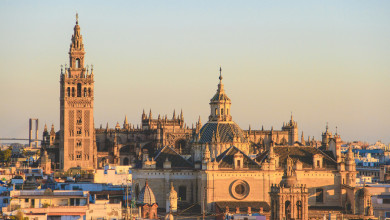Seville: history and interesting facts
Guides
Like in a dream, Seville transports you to the routes of emotion, in an evocative corner of Andalusia where history has left its mark and the present lives an effervescent modernity that makes this city one of the main economic, financial and cultural centres of southern Spain.
Seville is one of the most popular destinations for foreign visitors, seduced by the charm of the irresistible interweaving of the gothic design of its majestic cathedral, the splendor of its Baroque architecture and the inevitable presence of Arabic elements, a bright trace of the ancient Almohad dynasty.
Once in Seville, get to its heart and let yourself wander through the small streets that preserve its romantic, dreamy soul, treat yourself to nights that drip with flamenco, cerveza and plenty of joy, at a tapas bar or in the modern pubs of the Island of Cartuja.
Seville is rich with gardens and green spaces, is fun for children with the extraordinary Isla Magica theme park, and will charm adults with its churches, museums and galleries that are home to the highest level of the most famous contemporary artists.
Visits to the royal palaces of Alcazar, the famous tower of the Giralda or Barrio Santa Cruz are moments you never forget, along with an afternoon at the bullfights or a day spent wandering among boutiques and artisan shops, for a quality shopping experience that is accessible to anyone.
Don't miss Holy Week or the Fiesta de Abril, important celebrations that show the true face of Seville, a city that transmits a vibrant and engaging vibe for vacation filled with pure emotion.
History
Legend says that Hercules founded Seville, but it makes more sense to say that the Roman victory over the Carthaginians opened the doors to the Empire that, by order of Julius Caesar, made the inhabitants of ancient Hispalis citizens of Rome in 45 AD and spread Christianity in Andalusia.
After the invasion of the Visigoths and the brutal sacking of Seville in 426 AD, centuries of cultural and commercial development followed, soon forgotten with the arrival of the Arabs and the Almohad dynasty, which made the city the capital of the Caliphate of Cordoba.
This was a period of splendor for Seville, symbolized by the construction of the fortress of Alcazar, the spectacular mosque, the famous minaret (the Giralda) and the Torre de Oro (Golden Tower).
The invasion of Castile by Ferdinand III (1248) brought Seville back to Catholicism and the extraordinary cathedral of today was built in place of the mosque, while the Alcazar became the seat of the Kingdom of Castile and proof of the Reconquest of Seville.
The discovery of the Americas further reinforced the role of Seville which, with access to the sea guaranteed by the navigability of the Guadalquivir, welcomed the increased traffic and housed the Casa de Contratación (House of Trade), the main commercial institute of the kingdom of Isabella the Catholic and later Charles V.
At the beginning of the seventeenth century, Seville was the third city in the western world for population density and commercial wealth. This came to an end with the cover-up of the Guadalquivir and the terrible epidemics that later hit Europe.
After two centuries that made it known to the world as a tourist destination ("Carmen" by Bizet was set right here), Seville went back briefly to being the center of the world with the prestigious Universal Exposition of 1929 before suffering the violence of the Civil War and the Franco dictatorship.
The new urban image created by EXPO is manifested in the wondrous Plaza de España and Plaza America but it was the 1992 Exposition - which commemorated the 5th centennial of the discovery of the Americas – that renewed it with avant-garde buildings, the Alamillo bridge that leads to the Cartuja 93 Scientific and Technological Park and the high speed rail system.
Today Seville seems to be in perfect balance between the past and the present, with an extended historic center that is almost all pedestrian and the futuristic Metro line 1 that takes you over 22 km to every corner of the city.
Interesting Facts
NO8DO is the logo of the city of Seville and can be seen on the city's flag. It reads as follows: “no-madeja-do”, a phonetic expression of the city that means “no me ha dejado” (It - Seville - has not abandoned me), which refers to the loyalty shown to King Alfonso X by the people of Seville during his hard struggle for succession. Alfonso X was a tolerant and peaceful king, to whom the city owes a prosperous period and the expansion of the Alcazar.
Seville is the birthplace of the greatest exponents of Spanish Baroque, including Diego Velázquez and Bartolomé Esteban Murillo, and artists such as Francisco de Zurbarán and master Francisco Pacheco del Río.
The beautiful Paz Vega, a world famous actress and model, was born in Seville in 1976. Sensual and brilliant, she is known for her roles in "Talk to Her" By Pedro Almodovar and the scandalous film "Sex and Lucía".
“Carmen”, the opera that made Parisian composer Georges Bizet famous, is set in Seville. Passion, passion and passion! This masterpiece couldn't find a better setting elsewhere!
A legend of Barrio Santa Cruz tells the story of Suson, a rich Jewish conspirator who plotted to seize Seville without coming to terms with his daughter Susona. The girl, hopelessly in love with a young Christian, revealed the plot and the entire family was condemned to death. To atone for her guilt, before she died she asked that her skull be hung on the door to the house. It stayed there until the eighteenth century! Today, on Calle Susona, a small tile commemorates the event.
Where to stay in Seville
Looking for advice on where to stay?
Click here to consult the list of establishments registered on Nozio.com and book on their official website at the best conditions!

